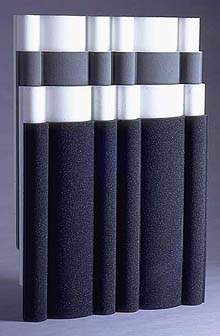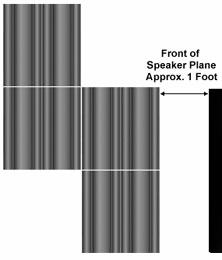![[SoundStage!]](../titles/sslogo3.gif) Home
Audio Home
Audio Equipment Review |
|||||||||||||||||
June 1999 RPG ProFoam by Doug Schneider
Room acoustics play such an enormous role in the final sound from a system you would think they would be one of the first areas attacked. Wrong! Truth be told, many audiophiles neglect outfitting their rooms, and for a wide variety of reasons, one of the key ones being cost. Building a custom room is a fabulous idea, but the cost is sky high and not many of us can afford that luxury. The next best thing is to take a good room and make it great. For that you need good acoustic products and the time to experiment. Unfortunately, most products can also cost big dollars. Then there is always the home-brew route -- roll-your own, so to speak. I've done it with some good results. However, you may save a lot of money, but you'll be out a considerable amount of time. What we want are good products that don't cost an arm and leg. Too cheap I say! I'm glad to say that when I recently went looking to tame some midrange and high-frequency nasties in a convenient cost-effective way, I was able to do it at a great price without having to resort to home-brew solutions. I scanned the Audio Advisor online catalog and found a product priced so affordably that I would guess those who feel the need to spend big money to achieve big results would overlook it. After all, what audiophile product could cost in the tens of dollars, not hundreds or thousands? "$49.95 for a set of 6?" I said aloud, somewhat startling my audiophile senses that are used to getting price-tag overload (note: RPG's list price is $58.10). "Uh, then give me 12," I replied thinking that most audiophile interconnects cost more than that. Approximately $100 (excluding shipping, which varies from place to place) and two days later the two RPG ProFoam boxes arrived at my doorstep. They look very nice in charcoal gray (other colors are available) and they have a special surface pattern tagged Variable Depth Air Cavity. According to the company's literature, VDAC[TM], as they call it, "provides minimum point of contact with the mounting surface, thus enabling most of the foam to be positioned away from the wall for optimum absorption." Besides, the VDAC[TM] thing makes it look cool too. Even people who hate the look of acoustic treatment may have trouble disliking this stuff. It's still a little techie, but it's not that techie. Problem/solution Being made out of a reasonably soft foam, the ProFoam panels have, according to the spec sheets, absorptive characteristics that work most effectively at 1kHz and above. Below that point its effects roll off rapidly, meaning that they won't affect the midrange to low-bass frequencies much at all. However, upper mids to highs can be tamed quite nicely when the panels are strategically placed. Generally, there are two methods for treating sound waves, absorption and diffusion. Since ProFoam is made of a fairly soft foam, it has absorptive characteristics at specific frequencies, its special profile helping to increase its effectiveness. What's more, the design of ProFoam allows it to be "nested," meaning stacked on top of each other, either partially or fully. The benefit in doing so is increased absorption by use of more foam. Of course, doing so increases the cost of its usage for a specific area, so experimentation is mandatory. In my case, I did not need to nest at all, although that may be something to try in the future. (For more information on acoustical concepts, see the section by Doug Blackburn immediately following this review.) My biggest room problem is on the side walls. I live in a large, heavy-duty apartment building with lots of concrete and the like as part of the wall structure. This is excellent for keeping the neighbor's noise out of my place; however, inside my apartment things get a little echoey at times. When standing at a point about two feet out from the speaker plane, I used to be able to clap my hands and hear slap echo bounce back and forth between the two side walls. It was also right at the position that is the first reflection spot for my speakers. All in all, not a good thing -- imaging and clarity were both impeded as a result.
Once the panels were hung in formation, I stood back and clapped my hands. Slap echo? Gone! Once I knew that the nasty echo had been tamed, I had a feeling that my system's mids and highs would be a little clearer too -- after all, they shouldn't be bouncing back and forth off those side walls. On went the music and, sure enough, the midrange and high frequencies improved in terms of clarity. Females voices were the worst culprit. Jewel's Spirit [Atlantic CD 82950] has good clarity, but a little too much high-frequency zing for my taste. When it is played at high levels, echoes in the room become all the more apparent. The ProFoam helped a lot. Resonances that could have been mistaken for the driver or cabinet of the speakers themselves were noticeably absent. The high frequencies had a tad less ringing, and the resolution, because of the increased clarity, stepped up a notch. No surprise that imaging became a bit more specific with better depth of stage and more focussed center image. Without surprise, the bass, upper bass and lower midrange weren't really affected. No problem -- that wasn't what I was going for anyway because I don't have those problems in my room. If I did, I would use other things like Tube Traps for the corners. While eliminating excessive echo may not seem like all that big an accomplishment to some people, for audiophiles who want to hear their system more than the walls of their rooms, it adds up to serious refinement and improvement. ProFoam = ProFound improvement I'm not really surprised with what the ProFoam does. I've heard lots of room acoustic treatments, including ASC Tube Traps, RPG Diffusors, Argent's Room Lens, among others. They all employ different technologies and all work well in specific ways when set up properly. Once heard, the effects of room treatment are not hard to believe, and it is then easy to understand why the room is so important. What surprises me about the RPG ProFoam is just how much it does for so little. While I'd imagine that there are those who will still balk at the idea of paying $50 for what is essentially foam, I disagree. The panels are designed specifically for audio applications, they look good, and frankly, they would take me a long time to re-create. My time is worth way more than that. I don't recommend getting one box; instead get two. For $100 you get an ample amount of foam to play with and really make it work. Follow the instructions and attack the key spots. Try "nesting" it too. For me, it was treating the first-reflection point on the left and right side walls that provided the biggest benefit. After that, treating the center of the front and back walls helped. For you it may be different, so don't be afraid to experiment. No, these will not be the solution to all of your room problems, but may work wonders for some specific ones. ...Doug Schneider
|
|||||||||||||||||
|
|||||||||||||||||
![[SoundStage!]](../titles/sslogo3.gif) All
Contents All
ContentsCopyright © 1999 SoundStage! All Rights Reserved |

 I had two boxes of ProFoam, 12
sheets in total to work with, so I planned out a strategy. I decided to use four sheets on
each of the side walls and employ the remaining four on the front and back walls should I
need them. I positioned the sheets on the side wall in sort of crooked-line positioning
that started at approximately one foot from the front of the speaker plane and very near
the floor. A nice thing about the ProFoam is that it is so light and easy to attach to the
walls that you can try a variety of ways. I would imagine you could use stick-pins
effectively, but I used three finishing nails per sheet to hang them. There are other ways
that you can get them up, but if you decide to nail, please note that you do not need to
pound the nail right into the wall as if you are hanging wall paneling or something heavy.
Instead, lightly tap the nail into the wall so it just holds the foam there. The
nail will stick out a half inch or so and line up evenly with the plane of the foam. This
way the foam doesn't get hammered down and scrunched up. Another way to do it is by using
that adhesive that RPG describes on their website. If you are not too worried about
what remains on the surface behind the ProFoam panels, this may be a good way to go.
I had two boxes of ProFoam, 12
sheets in total to work with, so I planned out a strategy. I decided to use four sheets on
each of the side walls and employ the remaining four on the front and back walls should I
need them. I positioned the sheets on the side wall in sort of crooked-line positioning
that started at approximately one foot from the front of the speaker plane and very near
the floor. A nice thing about the ProFoam is that it is so light and easy to attach to the
walls that you can try a variety of ways. I would imagine you could use stick-pins
effectively, but I used three finishing nails per sheet to hang them. There are other ways
that you can get them up, but if you decide to nail, please note that you do not need to
pound the nail right into the wall as if you are hanging wall paneling or something heavy.
Instead, lightly tap the nail into the wall so it just holds the foam there. The
nail will stick out a half inch or so and line up evenly with the plane of the foam. This
way the foam doesn't get hammered down and scrunched up. Another way to do it is by using
that adhesive that RPG describes on their website. If you are not too worried about
what remains on the surface behind the ProFoam panels, this may be a good way to go.